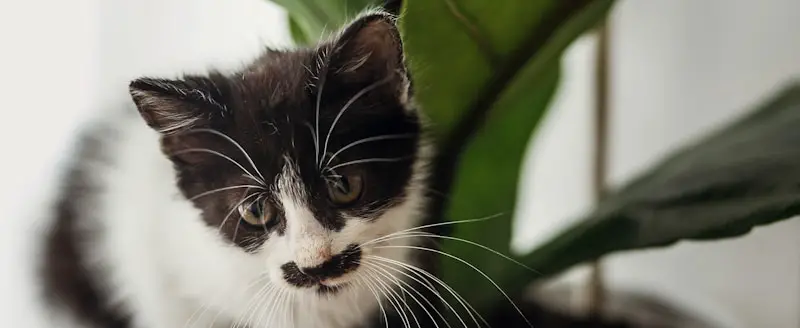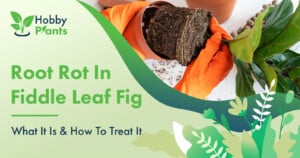Are you worried about the safety of your dog or cat with fiddle leaf figs? You are not alone because most pet owners express similar concerns. In fact, a commonly asked question by fiddle leaf fig owners is, are fiddle leaf figs toxic to dogs?
Fiddle leaf figs are toxic to cats, dogs, and people. They are mildly poisonous, and their sap can cause illness and irritation of the mouth, skin, throat, and stomach. However, their ingestion doesn’t necessarily lead to severe illness or death.
Fiddle leaf figs are not the best houseplants for pet owners because they are dangerous for your pets when ingested. Read on to discover how toxic fiddle leaf figs are to dogs and cats and how to protect your pets if you own this plant.
Are Fiddle Leaf Figs Toxic?
Sadly, fiddle leaf figs are toxic to pets and human beings. Their stems and leaves contain a white sticky sap consisting of small amounts of calcium oxalate crystals. These crystals have shaft edges that cause skin irritation. Also, fiddle leaf figs pose a significant risk when consumed.
When your pets consume the figs, they may experience irritation in the stomach, mouth, throat, or intestinal tract. The problems become severe if you do nothing about them. Therefore, keeping your fiddle leaf figs away from your pets and wearing gloves when handling them would be wise.
Are Fiddle Leaf Figs Toxic To Dogs?
Yes, fiddle leaf figs are toxic to dogs. If your dog takes a nibble at your fiddle plant, you may notice troubling symptoms like drooling and swelling of the mouth, tongue, or lips. Other symptoms of fiddle ingestion by dogs are excessive or lessened urination or thirst, vomiting, and diarrhea.
More so, your dog will likely paw at his mouth and show signs of breathing difficulty, weakness, or lethargy. The severity of the symptoms will depend on how much of the fiddle your dog has ingested. For instance, if your dog only took a small nibble at the plant, he will experience zero or very mild symptoms. On the other hand, the symptoms may become severe if your pet eats a large amount of the plant, like a whole leaf.
The sap from the fiddle’s stem or leaves causes skin and eye irritation. For instance, if the sap gets in your dog’s eyes, it may cause redness. It may also cause blistering and skin rashes if exposed to your dog’s skin.
Are Fiddle Leaf Figs Toxic To Cats?
Yes, fiddle leaf figs are toxic to cats. Cats are the most playful and curious pets that love jumping around and exploring new things. They are bound to get to your house plants and play, lick or nibble at them. When exposed to sap from the fiddle plant, your cats can experience skin or eye irritation.
Most cats respond to the irritation by licking off the sap, making the problem worse. Ingestion of fiddle leaf figs sap causes swelling and a burning sensation in the digestive system, which results in extreme discomfort. The effects may differ from mild to severe depending on the level of exposure and ingested amount.
How Do Fiddle Leaves Affect Dogs And Cats?
The sap from the fiddle leaves is the toxic component. Cats and dogs are the most affected by the sap because they easily play around, touch, and ingest the fiddle leaf figs. Here is how fiddle leaf figs affect your cats and dogs.
- Skin irritation
- Oral or mouth irritation and swelling
- Reduced or increased appetite
- Diarrhea
- Nausea or vomiting
Besides the symptoms above, fiddle leaf figs can affect your pets by causing distress. You can tell that your cat or dog is distressed by looking out for signs like;
- Constant mouth movement
- Drooling
- Pawing
- Licking
- Scratching
Also, fiddle leaf figs can affect your dog or cat’s physical activity. For instance, fiddle leaf fig poisoning causes fatigue and tiredness for your pets. While these effects are not mainly fatal, you should not take any symptoms lightly.
What Do You Do When Your Pet Consumes Fiddle Leaves?
Most pet owners assume the symptoms of fiddle leaf fig ingestion because they are typically not lethal. However, failure to respond to them accordingly could be dangerous for your pets. Below are some things you should do if you notice any of the symptoms mentioned earlier.
Talk To A Certified Vet
Book an appointment with a reliable vet immediately. Then explain that your pet has ingested fiddle leaf and the symptoms showcased when making the appointment. A vet will assess your pet and administer the right medication or management based on the symptoms. For instance, the vet might rinse your pet’s mouth with distilled water and administer emetic to induce vomiting. This helps flush the undigested plant from your plant’s system.
Inspect The Plant
Inspecting the plant will show you how much of the plant your pet has ingested. The symptoms may be sap-related even if your pet has not chewed the plant. Your vet will most likely want to know how much of the plant your pet ingested to establish the right medical treatment.
Rinse Your Pet’s Mouth
It helps if you rinse your pet’s mouth fast enough to remove any lingering residue from the plant. Doing this will minimize the oral irritation and prevent your pet from swallowing more toxins.
FAQs On Fiddle Leaf Figs Toxicity To Dogs & Cats
As a pet owner, we understand how much effort you must put into keeping your furry babies safe. An accident will have you asking so many questions, especially about fiddle leaf fig toxicity to your pet. Below are answers to some of the most frequent questions.
How Toxic Are Fiddle Leaf Figs?
Fiddle leaf figs are mildly toxic. These plants have Class 4 plant toxicity levels; they contain some oxalates and cause mild to severe symptoms when ingested or in contact with the skin.
Can You Make Fiddle Leaf Figs Friendly To Dogs And Cats?
You cannot make the fiddle leaf fig friendly to dogs and cats. However, your fiddle fig can co-exist with your pets with the right tips. Here are some things you can do to protect your dogs and cats from fiddle leaf fig poisoning.
- Keep the plant out of reach.
- Prune the bottom leaves and collect any leaf droppings to prevent your cats and dogs from accessing them.
- Leave some orange or lemon peels around the pot. The strong citrus smell from the peels will keep your pets away from the plant.
- Use pepper to repel your dogs from the plant.
- You can also train your pet to stay away from the plant by spraying or scaring them when they move near it.
Which Pets Are Most Vulnerable To Fiddle Leaf Fig Poisoning?
All pets, like cats, dogs, rabbits, birds, and guinea pigs, are vulnerable to fiddle leaf fig toxicity. Therefore, if you have any pets in your house, you need to worry about their exposure to the fiddle toxicity.
Conclusion
Fiddle leaf figs are not the best houseplants for pet owners because of their toxicity. They cause mild to severe discomforts when dogs and cats consume them or get in contact with the plant’s sap. However, the leaf figs are not deadly poisonous for pets.
That notwithstanding, if you own pets and have the fiddle leaf fig as a houseplant, always be on the lookout for symptoms of fiddle poisoning. If you cannot protect your pets from the plant, you should consider a different plant altogether.
Also read: Root Rot In Fiddle Leaf Fig – What It Is & How To Treat It
Victoria is the owner and main author of hobby plants. She loves spending her free time in her garden planting and taking care of her plants. Victoria hopes you enjoy the content here!


![Why Is My Fiddle Leaf Fig Dropping Leaves? [ANSWERED] Why Is My Fiddle Leaf Fig Dropping Leaves? [ANSWERED]](https://www.hobbyplants.com/wp-content/uploads/2022/06/why-is-my-fiddle-leaf-fig-dropping-leaves-300x158.jpg)
![Fiddle Leaf Fig Outdoors - Can They Survive? [ANSWERED] Fiddle Leaf Fig Outdoors - Can They Survive? [ANSWERED]](https://www.hobbyplants.com/wp-content/uploads/2022/07/fiddle-leaf-fig-outdoors-300x158.jpg)
![How to Propagate Fiddle Leaf Fig [BEST METHODS] How to Propagate Fiddle Leaf Fig [BEST METHODS]](https://www.hobbyplants.com/wp-content/uploads/2022/06/how-to-propagate-fiddle-leaf-fig-300x158.jpg)
![How to Repot a Fiddle Leaf Fig [COMPLETE GUIDE] How to Repot a Fiddle Leaf Fig [COMPLETE GUIDE]](https://www.hobbyplants.com/wp-content/uploads/2022/06/how-to-repot-a-fiddle-leaf-fig-300x158.jpg)

![What Are The Types Of Dracaena Plants [Answered] What Are The Types Of Dracaena Plants [Answered]](https://www.hobbyplants.com/wp-content/uploads/2022/07/types-of-dracaena-plants-300x158.jpg)
![What Is Bright Indirect Light For Plants? [ANSWERED] What Is Bright Indirect Light For Plants? [ANSWERED]](https://www.hobbyplants.com/wp-content/uploads/2022/08/what-is-bright-indirect-light-300x158.jpg)